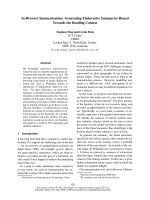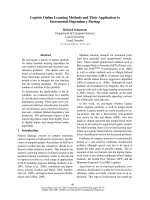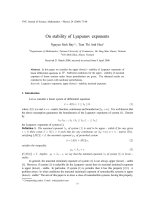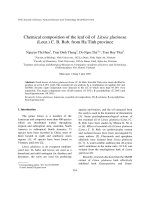Báo cáo " On equations of motion, boundary conditions and conserved energy-momentum of the rigid string " doc
Bạn đang xem bản rút gọn của tài liệu. Xem và tải ngay bản đầy đủ của tài liệu tại đây (157.46 KB, 8 trang )
VNU Journal of Science, Mathematics - Physics 24 (2008) 111-118
On equations of motion, boundary conditions and conserved
energy-momentum of the rigid string
Nguyen Suan Han*
Department of Physics, College of Science, VNU, 334 Nguyen Trai, Thanh Xuan, Hanoi, Vietnam
Received 28 June 2008
Abstract. The correct forms of the equations of motion, of the boundary conditions and of the
reconserved energy - momentum for the a classical rigid string are given. Certain consequences
of the equations of motion are presented. We also point out that in Hamilton description of
the rigid string the usual time evolution equation
˙
F = { F, H} is modified by some boundary
terms
1. Introduction
The modified string model, so-called rigid or smooth strings, has been discussed [1 − 11]. The
action functional in this model contains in addition to the usual Nambu-Gato the term proportional to
the external curvature of the world sheet of the string.These models are expected to have many different
applications in string interpretation of QCD, in a statistical theory of random surfaces, in connection
with two dimensional, quantized gravity [12].
Our main goal in this paper is to re-derive the classical equations of motion, boundary conditions
and conserved energy - momentum of the rigid string, obtained by [4 −6]. The first reason to discuss
in detail such basis is that rigid model is an example of a Lagrangian field theory with higher order
derivatives. In such case the seemingly standard derivations contain many interesting points which
in our opinion, have not been sufficient emphasized. The second reason is that one can find in
the literature many misleading or even erroneous statements concerning in equations of motion, the
boundary conditions and the energy-momentum.
The plan of our paper is the following. In Section 2 we present the derivation of the Euler
-Lagrange equations of motion, of the boundary conditions and of the conserved energy-momentum in
the case of genetic Lagrangian with second order derivatives . In Section 3 we present the corresponding
formulae in the case of rigid string, i. e. for the specific Lagrangian given at the beginning of Section
3. There we also derive some simple consequences of the equations of motion. In the Section 4 we
point out the peculiar features of the Hamiltonian formalism appearing in the case of the open string.
∗
E-mail:
111
112 N.S. Han / VNU Journal of Science, Mathematics - Physics 24 (2008) 111-118
2. The Formalism
Let us suppose that the Lagrangian density L depends on the field function x
µ
(τ, σ) and on
their first and second derivatives.
S =
Ω
d
2
uL(x
µ
, x
µ,i
, x
µ,ij
) =
τ
2
τ
1
dτ
σ
2
σ
1
dσL(x
µ
, x
µ,i
, x
µ,ij
). (1)
For the partial derivatives we introduce the following notation:
x
µ,i
=
∂x
µ
∂u
i
, x
µ,ij
=
∂x
µ
∂u
i
∂u
j
; i, j = 1, 2;
˙x
µ
=
∂x
µ
∂τ
; ´x
µ
=
∂x
µ
∂σ
. (2)
where x
µ
= x
µ
(τ, σ) are fields in the two -dimensional space-time u
0
= τ; u
1
= −∞ < τ < +∞;
µ = 0, 1, 2, , D −1 The following formula for the full variation of the action S is given
δS =
Ω
{Λ
µ
+ ǫ
ij
∂
i
Π
j
+ ∂
0
∂
1
Z}, (3)
where
ε
i,j
=
0 1
−1 0
ε
i,j
∂
i
Π
j
= ∂
0
Π
j
− ∂
1
Π
0
(4)
Λ
µ
(τ, σ) =
∂L
∂x
µ
−
∂
∂τ
∂L
∂ ˙x
µ
−
∂
∂τ
∂L
∂¨x
µ
+
∂
∂σ
∂L
∂
˙
x
′
µ
= (5)
= −
∂
∂σ
∂L
∂x
′
µ
−
∂
∂σ
∂L
∂x”
µ
;
Π
0
(τ, σ) =
−
∂L
∂x
µ
,1
+ ∂
i
∂L
∂x
µ
,0i
δx
µ
−
∂L
∂x
µ
,11
δxµ
,1
; (6)
Π
1
(τ, σ) =
∂L
∂x
µ
,0
− ∂
i
∂L
∂x
µ
,0i
δx
µ
+
∂L
∂x
µ
,00
δxµ
,00
δxµ
,0
; (7)
Z(τ, σ) =
∂L
∂x
µ
,01
δxµ. (8)
Using Stokes theorem we can write δS in the following form
δS =
Ω
d
2
uΛ
µ
δu
µ
+
δΩ
U
i
du
i
+ [Z(τ
2
, π) − Z(τ
2
, 0) + Z(τ
1
, π) − Z(τ
1
, 0)], (9)
where δΩ denotes the boundary of the rectangle Ω. The advantage of the form of the variation δS is
that it involves the least possible number of derivatives of the variations δx
µ
. The remaining derivatives
of δx in formula (9) cannot be removed by any partial integrations. The Z-terms in formula (9) for
δS can be regarded as a contribution from the corner points of the rectangle R. For the closed string
they cancel each other. However, for the open string they give a nonvanishing contribution if the
Lagrangian L depends on
∂
2
x
µ
∂u
0
∂u
1
.
N.S. Han / VNU Journal of Science, Mathematics - Physics 24 (2008) 111-118 113
The Z-terms have appeared because in this case of open rigid string we encounter a coincidence
of the following two mathematical obstacles: the presence of the high derivatives in the Lagrangian ,
and the fact that the field x
µ
(τ, σ) is defined on the finite strip 0 σ π, and −∞ < τ < ∞, which
has boundaries. The classical equations of the motion and the boundary conditions for the open rigid
string follow from the requirement
δS = 0 ⇔ Λ
µ
(τ, σ) = 0, (10)
for the any variation δx
µ
obeying following conditions
δx
µ
(τ, σ) = 0, τ = τ
1
, τ
2
; σ ∈ [0, π]; (11a)
δx
µ,0
(τ, σ) = 0, τ = τ
1
, τ
2
; σ ∈ [0, π]. (11b)
This conditions (11b) is due to the fact that Lagrangian contains the second order derivatives
with respect to the evolution τ . From (2.11b) it follows that
δx
µ,1
(τ, σ) = 0, for τ = τ
1
, τ
2
; σ ∈ [0, π]. (12)
On the other hand, neither δ x
µ
nor δx
µ,1
, are fixed for σ = 0, σ = π, τ ∈ (τ
1
, τ
2
). Now, it
is clear that the requirement (1 0) implies the following equations of motion
Λ
µ
(τ, σ) = 0, (13)
and the following boundary conditions
B
µ
(τ, σ = 0) = 0, B
µ
(τ, σ = π) = 0, (14)
C
µ
(τ, σ = 0) = 0, C
µ
(τ, σ = π) = 0, (15)
where
B
µ
(τ, σ) =
∂L
∂x
µ,1
+ ∂
i
∂L
∂x
µ,1i
, (16)
B
µ
(τ, σ) =
∂L
∂x
µ,1
+ ∂
i
∂L
∂x
µ,1i
, (16)
and
C
µ
(τ, σ) =
∂l
∂x
µ,11
. (17)
In the case of the closed string δ
µ
(τ, σ) obey the conditions δ
µµ
(τ, σ = 0) = δ
µ
(τ, σ = σπ).
Then, the variation principle implies only the equations motion (13).
Now, let us pass to the derivation of the energy-momentum four-vector corresponding to the
action . We again use the formula
δx
µ
= ǫ
µ
= const. (18)
Assume the Lagrangian is invariant,
∂L
∂x
µ
= 0 and δS = 0 with the conditions x
µ
(τ, σ) obeys
the equations of motion (1 3), and conditions (14) and (15). From (9) we have
P
µ
=
π
0
dσ
−
∂L
∂x
µ,0
+ ∂
i
∂L
∂x
µ,0i
−
∂L
∂x
µ,01
σ=π
+
∂L
∂x
µ,1
σ=0
, (19)
114 N.S. Han / VNU Journal of Science, Mathematics - Physics 24 (2008) 111-118
is constant during the τ-evolution .We notice that the two last terms on the right hand side of formula
(19) cancel with the term
π
0
dσ∂
1
(
∂L
∂
µ,01
). Therefore the final formula for the energy- momentum four
-vector has form
P
µ
=
π
0
dσp
µ
; p
µ
=
−
∂L
∂x
µ,0
+ ∂
i
∂L
∂x
µ,0i
. (20)
where
∂
1
B + ∂
0
p
µ
= 0, (21)
Integrating formula (21) over σ, and taking into account boundary conditions (14) we again
obtain that
∂
0
p
µ
= 0. (22)
This is a check that our formulae (21) and (22) are correct. By a similar reasoning we obtain
a conserved angular-momentum tensor M
µν
for rigid string. The only difference is that now
δx
µ
= ω
µν
x
ν
. (23)
instead of formula (18). Here ω
µν
= −ω
νµ
are the six infinitesimal parameters of Lorentz transfor-
mations. After a partial integration, contribution of the Z-terms is canceled by each other.The final
formula forM
µν
has the following form.
M
µν
=
π
0
dσ(x
µ
p
ν
− x
ν
p
µ
) +
π
0
dσ
∂L
∂x
µ,0i
x
ν,i
−
∂L
∂x
ν,0i
x
µ,i
, (24)
where p
µ
is the momentum density given by formula (20)
3. The Rigid String
For the rigid string the Lagrangian has the form
L =
√
−g(−γ + α✷x
µ
✷x
µ
), (25)
✷x
µ
=
1
√
−g
∂
∂u
i
√
−gg
ij
∂x
µ
∂u
j
= g
ij
∂
2
x
µ
∂u
i
∂u
j
+
1
√
−g
∂
∂u
i
√
−gg
ij
∂x
∂u
j
= (26)
=
1
√
−g
∂
∂τ
( ˙xx
′
) x
′µ
−x
′2
x”
√
−g
+
∂
∂τ
( ˙xx
′
) x” −
˙
x
′
µ
− x
′2
x
′µ
√
−g
,
where γ > 0 is the constant with dimension of the squared mass, α = 0 is the dimensionless constant
which specifies the rigidity of the string world sheet. ✷ is the Laplace-Beltrami operator for the
metric tensor g
ij
.g = det g
ij
.In the Minkowski space-time the metric with signature η
µν
=
diag(+1, −1, −1, −1, ) For α = 0 we would obtain the usual Nambu-Gato string.In the case of
Lagrangian (25) equations of motion have the form
(γ −α✷x
µ
✷x
µ
)✷x
µ
+ 2α
✷(✷x
µ
) −g
ij
x
ν
,i
x
µ,j
✷(✷x
ν
)
−4αg
ij
g
kz
(✷x
ν
)
,j
x
ν
,k
∇
i
x
µ,z
= 0 (27)
where ∇
a
x
∇
i
x
µ,z
= x
ν,ij
η
µν
−g
kz
x
ν,z
x
µ,k
, (28)
Equation (27) are very complicated . They contain fourth -order partial derivatives and nonlin-
earities . For α = 0 they reduce to equations of motion for the Nambu-Gato string.
✷x
µ
= 0. (29)
N.S. Han / VNU Journal of Science, Mathematics - Physics 24 (2008) 111-118 115
Equations (29) are also nonlinear . However, it is a well-known fact that they can be locally
linearized by choosing so called orthonormal coordinates on the world sheet with following conditions
x
˙
x
′
= 0,
˙
x
2
> 0, x
′2
< 0,
˙
x
2
= −x
′2
(30)
✷x
µ
= 0 ⇔
∂
2
0
− ∂
2
1
x
µ
(τ, σ) = 0. (31)
The functions B
µ
(τ, σ), C
µ
(τ, σ) which appear in boundary conditions in the case of Lagrangian
(25) have following form
B
µ
(τ, σ) =
√
−g(γ −α✷x
µ
✷x
µ
)g
1i
x
µ,i
+ 2α
√
−gg
jk
x
λ
,i
x
λ,jk
✷x
µ
+ eqno(3.8)
+4α
√
−g✷x
σ
x
σ
,ij
g
1j
G
ik
x
µ,k
+ 2α∂
0
√
−gg
01
✷x
µ
+ 2α∂
j
√
−gg
1j
✷x
µ
;
C
µ
(τ, σ) = 2α
√
−gg
11
✷x
µ
. (32)
The energy-momentum density p
µ
has the following form
P
µ
=
√
−gg
0j
(γ −α✷x
σ
✷x
σ
)x
µ,j
+ 2α∂
0
√
−gg
00
✷x
µ
+ (33)
+2α
√
−gg
0i
g
jk
2✷x
σ
x
σ
ij
x
µ,k
+ x
λ
,jk
x
λ,i
✷x
µ
In the orthonormal coordinates this formula is simplified to
p
µ
= ˙x
µ
γ(NG) − α
¯
∂
2
x
µ
¯
∂
2
x
µ
˙
x
2
2
+ 4α
¯
∂
2
x
σ
¨
x
σ
˙
x
2
2
+ 2α∂
0
1
˙
x
2
¯
∂
2
x
µ
−
4α
˙
x
2
¯
∂
2
x
σ
˙
x
′
x
′
µ
. (34)
In the Nambu-Gato α = 0
p
µ
= γ ˙x
µ
. (35)
Investigations of the rigid string model are not easy to carry out because equations of motion of
the classical string and the corresponding canonical structure are rather complicated.
4. Hamilton description of the open rigid string
Discussion of Hamilton formulation of dynamics of systems with reparametrization invariance,
which is a special case of local gauge invariance, is complicated by a problem of constraints. In order
to avoid this obstacle we shall discuss the Hamilton description of the rigid string in the physical
gauge, which is defined by the requirement that the evolution parameter τ is equal to the physical time
x
0
x
0
(τ, σ) = τ. (36)
In this gauge, the independent dynamical variables are x
i
(t, σ), i = 1, 2, 3 t = x
0
. Variations
are now replaced by
x(τ, σ) → x(τ, σ) + δx(τ, σ), (37)
where
−→
x = x
i
. The considerations of section 2 can be repeated with the only difference that the index
µ = 0, 1, 2, 3 is now replaced by the index i = 1, 2, 3. In particular,the equations of motion (13) and
the boundary conditions have the form given by formula (14 −15) with the replacement µ → i. From
the invariance under the spatial translations
δx = ǫ = const, (38)
116 N.S. Han / VNU Journal of Science, Mathematics - Physics 24 (2008) 111-118
S =
t
2
t
1
dt
π
0
dσL
x,
˙
x,
x
′
,
¨
x,
˙
x
′
,
x”
. (39)
The result is
P
0
=
π
0
dσ
¨
x
∂L
∂
¨
−→
x
+
˙
x
∂L
∂
˙
x
−∂
0
∂L
∂
˙
x
+
˙
x
∂L
∂
˙
x
−L
, (40)
In order to obtain this formula , the equations of motion and and the boundary conditions have
been used. Also some partial integrations over σ have been performed
In the case of Lagrangian L with second order derivatives there are two independent ”configu-
ration space-type” variables
q
1a
= x
a
, q
2
= ˙x
i
, (41)
and the corresponding canonical momenta
p
1a
= −
∂L
∂q
2a
+
∂
∂τ
∂L
∂ ˙q
2
+
∂
∂σ
∂L
∂q
′
2a
. (42)
The Lagrangian L is regarded as a function of variables q
1
, ´q
1
, q
2
, ˙q
2
, ´q
2
.The Hamilton is defined
by the formula
P
2a
= −
∂L
∂ ˙q
2a
, (43)
where ˙q
2
is unique function of p
2
and of the other variables obtained by solving for ˙q
2
. The function
˙q
2
is unique because we have fixed the gauge. The equations of motion (13) are equivalent to the
following set of Hamilton equations of motion:
¯
H = −p
1a
q
2a
− p
2a
˙q
2a
−L
q
1
, q
′
1
, q ”
1
, q
2
, ˙q
2
, q
′
2
, (44)
˙q
1
= −
δH
δp
1
; ˙q
2
= −
δH
δp
2
, (45)
˙p
1
=
δH
δq
1
; ˙p
2
=
δH
δq
2
, (46)
where
¯
H =
¯
H
q
1
, q
′
1
, q ”
1
, q
2
, ˙q
2
, q
′
2
is Hamilton functional
H =
π
0
dσ
¯
H =
π
0
dσ
¨
x
∂L
∂
¨
x
+
˙
x
∂L
∂
˙
x
−∂
0
∂L
∂
¨
x
− ∂
1
∂L
∂
˙
x
−L
, (47)
and
δH
δq
1
=
∂
¯
H
∂q
1
−
∂
∂σ
∂
¯
H
∂q
′
1
+
∂
2
∂σ
2
∂
¯
H
∂q”
1
, (48)
δH
δq
2
=
∂
¯
H
∂q
2
−
∂
∂σ
∂
¯
H
∂q
′
2
;
δH
δp
1
=
∂
¯
H
∂p
1
;
δH
δp
2
=
∂
¯
H
∂p
2
,
are variational derivatives of the functional H. Comparing H with the energy P
0
we see that
H = P
0
−
π
0
dσ∂
1
˙
x
∂L
∂
˙
x
= P
0
−
˙
x
∂L
∂
˙
x
σ=π
σ=0
. (49)
Thus, in the case of the open string H differs from P
0
.
F =
π
0
dσ
¯
F
q
1
, q
′
1
, q ”
1
, q
2
, q
′
2
, p
1
, p
2
. (50)
N.S. Han / VNU Journal of Science, Mathematics - Physics 24 (2008) 111-118 117
Using Hamilton equations of motion (47) we may write
dF
dt
=
π
0
dσ
∂
¯
F
∂q
1
˙q
1
+
∂
¯
F
∂q
′
1
˙
q”
1
+
∂
¯
F
∂q
2
˙
q
′
2
+
∂
¯
F
∂p
1
˙p
1
+
∂
¯
F
∂p
2
˙p
2
= (51)
=
π
0
dσ
δF
δq
1
˙q
1
+
δF
δq
2
˙q
2
+
δF
δp
1
˙p
1
+
δF
δp
2
˙p
2
+
+
∂
¯
F
∂q
′
1
−
∂
∂σ
∂
¯
F
∂q”
1
˙q
1
σ=π
σ=0
+
∂F
∂q”
1
˙q
1
σ=π
σ=0
+
∂
¯
F
∂q
′
2
˙q
2
σ=π
σ=0
(52)
Equation (50) has a rather usual implication that Hamilton H might not be a constant at the
motion. From Eq. (50) it follows that
dF
dt
= {F, H}+ ”the boundary terms” (52)
where Poisson bracket { F.H} is by definition
{F , H} =
π
0
dσ
δF
δp
1
δH
δq
1
−
δH
δp
1
δF
δq
1
+
δF
δp
2
δH
δq
2
−
δH
δp
2
δF
δq
2
(53)
The boundary terms (the last three terms on the right hand side of formula (50)) vanish in the
case of closed string. In the case of open string they give a non-vanishing contribution even in the
case of Nambu-Gato string.
dF
dt
= ”the boundary terms”, (54)
because of boundary condition (14) which in this case reduces to
∂L
∂
a´
= 0 for σ = 0, π. In the case of
Lagrangian L with second order derivatives , boundary condition (53) to the form
∂
¯
H
∂x
′
σ=π
σ=0
= −
∂L
∂x
′
σ=π
σ=0
= 0. (55)
In the case Nambu-Gato string the boundary terms in Eq. (53) reduce
dH
dt
= −∂
0
π
0
dσ∂
1
˙
x
∂L
∂
˙
x
. (56)
The right side of equation (55) does not vanish, in general . Therefore,
dH
dt
= 0. From equation
(55) it follows that
H +
π
0
dσ∂
1
˙
x
∂L
∂
˙
x
, (57)
is constant during the motion, but this just the energy P
0
is given by formula (39). In general, the
boundary terms will also be present in other gauges, because their appearance is due to the facts that
the Lagrangian contains second order derivatives and range of the parameter σ is finite.However, in
some particular cases the boundary terms can vanish. For example , in papers a gauge is used which
is physical, i. e x
0
(τ, σ) = τ, and orthogonal, i. e.
−→
˙x
−→
´x = 0,
118 N.S. Han / VNU Journal of Science, Mathematics - Physics 24 (2008) 111-118
5. Conclusion
The equations of motion, of the boundary conditions and of the energy - momentum for the
classical rigid string are reconserved. Certain consequences of the equations of motion are presented.
We also point out that in Hamilton description of the rigid string the usual time evolution equation
˙
F = { F, H} is modified by some boundary terms.
Acknowledgements. The author would like to thank Profs. B.M.Barbashov,V.V.Nesterenko for useful
discussions This work was partly supported by Vietnam National Research Programme in National
Science N 406406.
References
[1] T.Goto,Prog. Theor. Phys. 46 (1971) 1560.
[2] Y. Nambu, Lectures at the Copenhagen Summer Symposium, 1970 (unpublished)
[3] B.M. Barbashov, N.N. Nesterenko, Relativistic String Model, World Scientific, Singapore 1990.
[4] Nguyen Suan Han, V.V. Nesterenko, Inter. J. of Modern Phys. A3. No 10 (1988)2315.
[5] H. Arodz, A. Sitarz, P. Wegrzyn, Acta Physics Polonica B, 23, No 1 (1992)53.
[6] P. Wegrzyn, Phys. Rev. D50 , No 4 (1994) 2769.
[7] Bin He, Zi-Ping Li, C ommunications in Th eoretical Ph ysics, 23(1995) 371.
[8] Zi Ping Li, Phys. Rev. E50 (1994) 876.
[9] A. Polyakov, Nucl. Phys. B268 (1986) 406.
[10] H. Kl einert, Phys. Lett. 174B (1986)335.
[11] D.M. Git man, I.V. Tyurin, Canonization of Con strained Fie lds,(in Russian) M. Nauka, 1986.
[12] J. Ambjorn, Acta Phys. Pol. B20 (1989) 313.









